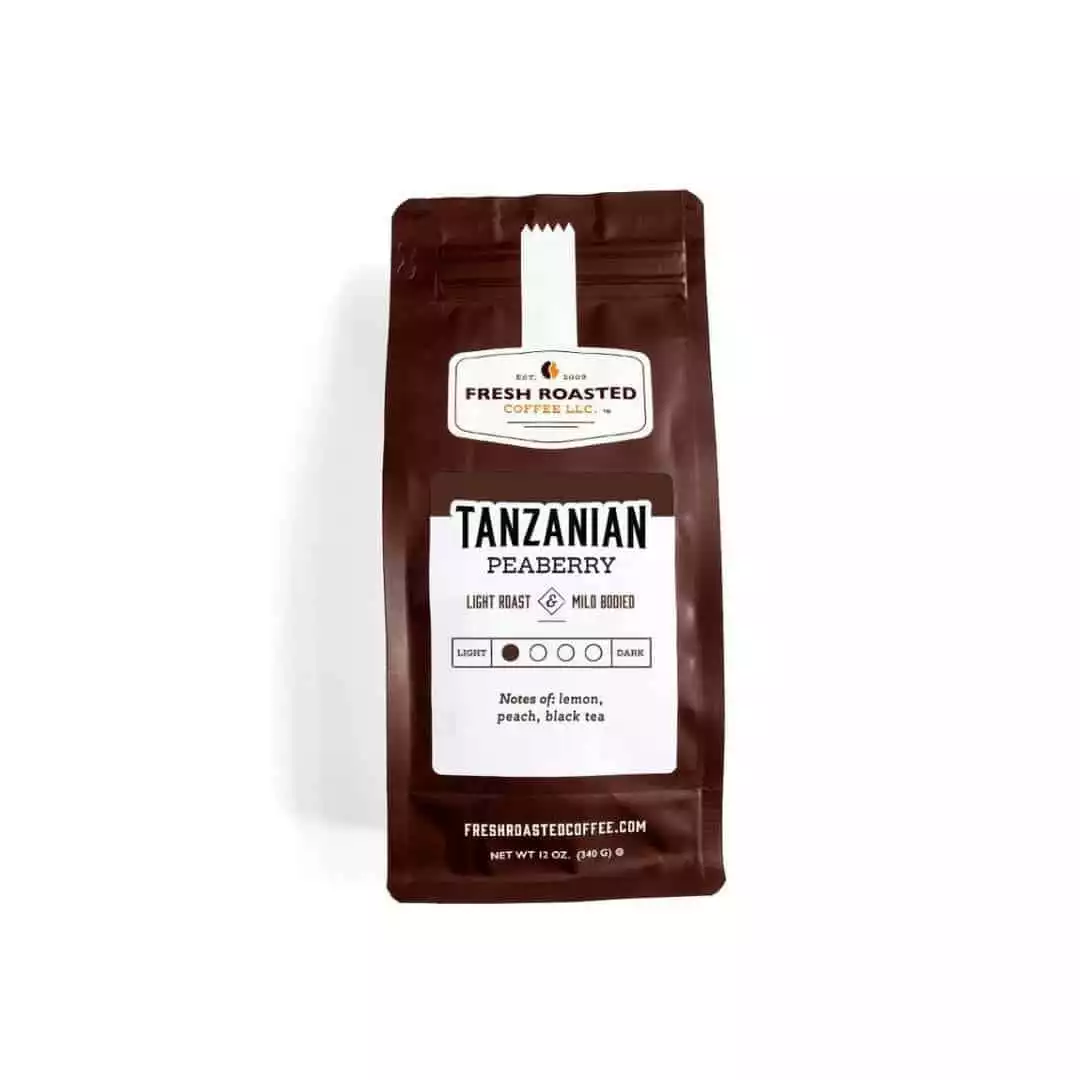Tanzania Peaberry Coffee: The Ultimate Guide
Tanzania is an exciting, emerging origin. It would seem that with each harvest, the coffee offerings from this East African country keep getting better, with some really excellent coffees being produced. But rather than being known for its high quality lots, Tanzania has become synonymous with something else— peaberry coffee.
Tanzania peaberry coffee— what is it? A coffee varietal? A mutation? Maybe even a defect? Let’s find out!

Tanzania Coffee History
Tanzania shares borders with some of the best coffee producing countries on the planet. While it is often overshadowed by Kenya to the North, Tanzania produces some steller coffees that are just as good as its high-profile neighbor. It also produces almost as much as Kenya too, exporting around 790,000 60kg sacks annually.
The history of coffee in Tanzania, being so close to the birthplace of Arabica coffee, Ethiopia, is long-standing, extending long before colonization. While it wasn’t produced for commercial purposes until the 1890s, coffee was used by the local people as a fruit that was chewed on, rather than a bean brewed into a beverage.
During the time of German colonization, rules were set in place that mandated farmers only grow the arabica species, rather than the robusta that was commonly grown at the origin. This burgeoning coffee industry was set around Mt. Kilimanjaro— where much of the specialty grade coffee is still grown today. By 1983, arabica coffee had become a fairly successful crop.
Vibrant and fruity, with a mild body and citrus undertones.
With Germany losing control of the colony post World War I, the country, which was called Tanganyika at the time, became a British colony.
British colonists tried to expand the coffee industry in the country, spreading coffee to the West in an attempt to increase production. This attempt was largely unsuccessful— production didn’t increase until much later.
Coffee from Tanzania hadn’t yet gained momentum, nor had it developed the name for itself that it has today. No-one had heard much of Tanzanian coffee, and certainly not of Tanzanian peaberry.
In 1964, after Tanganyika and Zanzibar were both granted independence, they were combined to form the Republic of Tanzania.
One of the key economic strategies for the new government in Tanzania was to boost the coffee industry. Many farms were nationalized, becoming state-run cooperatives. Long story short— this attempt to increase efficiency and production failed terribly.
Eventually, the industry was privatized, allowing producers to sell more directly to coffee buyers, and the coffee industry in Tanzania took the approximate shape that we see now.
Today, all over the world, Tanzanian coffee is known for two things, depending on where you are. If you are in Japan, Tanzanian coffee is famous, often branded as Mount Kilimanjaro coffee— known for being of exceptional quality. In the West, coffee lovers adore Tanzanian peaberry.
So regardless of where you are from, you probably have high hopes when a bag of coffee is grown in Tanzania. Why is the coffee from Tanzania so good? Location, location, location! Not to mention much skill, labor, and dedication.
Tanzania: Geography & Climate
For delicious coffee to grow, the trees need a few things. Well, in reality, they need loads of different things, but in short, they need nutrient-rich soil, high elevation, and adequate access to water.
Tanzania, with its mountainous terrain and volcanic, rich soil, offers the perfect home for a beautiful coffee tree.
Coffee is grown in Tanzania across pretty much all highland areas of the country. These mountainous, volcanic areas provide the plants with nutrient-rich soil. They also provide the altitude that arabica needs to thrive. Plant the coffee too low, the cherries will grow too fast, resulting in a bland seed lacking sweetness and solid acidity. Lower altitudes are also usually too warm for arabica to grow.
While the coffee industry started around the slopes of Mt. Kilimanjaro, it has since spread all the way to the West of the country to well-known regions like the Mbozi and Mbeya region. The Mbeya region is currently the most productive coffee-growing region in the country.
Today, production is spread across nine main growing regions— Mara, Kilimanjaro, Ruvuma, Mbeya, Kigoma, Arusha, Manyara, Bukoba & Kagera.
Why Tanzanian Peaberry coffee?
Let’s take 100 standard coffee cherries. You can pick any varietal you’d like— bourbon, kent, blue mountain— anything. Now let’s open up the fruit of all of these cherries and expose the seeds.
Inside most of these cherries, we’ll find two seeds, sitting with the flat sides face-to-face. These are the seeds that most will recognize as a regular coffee bean.
Vibrant and fruity, with a mild body and citrus undertones.
While most of these cherries will have two flat beans, there will be a certain percentage of any coffee lot, between 5 and 12%, that will have only one, round-ish ‘pea-like’ seed. This seed is known as a peaberry and is a natural mutation that occurs within most varietals.
Peaberries are the result when the one ovule within the cherry fails to pollinate. This leaves plenty of extra room for the one developing seed to grow larger and rounder than a standard single seed would.
There are some varietals and origins that see peaberries more frequently, but these cherries will pop-up regardless of where they are grown or from which tree they grew.
Peaberry is not a variety but a mutation
Given that only about 10% of a lot might be peaberries, how do we end up with a whole bag of them to roast? And why do we see Tanzanian peaberry or Kenyan peaberry more than we see Colombian peaberry coffee beans?
High-quality coffee from Tanzania is carefully sorted to ensure uniformity of screen size. Basically, the producer and the team at the farm sort the coffees so that all the cherries in one batch are the same size. This will ensure that all the beans within these cherries are of a similar size, which is important for uniform coffee roasting.
When we roast, we want all the coffee beans to roast the same amount, all the way through to the inside of the bean. This is known as ‘bean development’ and it is crucial for delicious flavor.
Whether it’s a light roast or a medium roast, full development is essential. When performing a light roast, there is a much higher chance of inadequate development, as the coffee is roasted for less time and with less heat than a medium roast.
If a roaster uses beans that are all different sizes, chances are that some of the beans will end up over-developed, while others might be under-developed. Over-developed beans will taste like the roast, otherwise known as ‘roasty’. Under-developed beans will present grass and hay flavor notes in the cup.
The sorting process will separate the peaberries from the regular coffee, as the peaberry cherries are smaller than regular cherries. Because only relatively few of the cherries that come off a tree are peaberry, there is a limited quantity of them available. And as a result of the limited quantities, and the extra labor required to sort these coffees, peaberry coffee is usually more expensive.
We see peaberry coffees coming from all over the world. They aren’t super common because not all producers put in this work of separating them from the bulk of the harvest.
If you hunt through a bag of coffee, there is a pretty good chance you’ll find a peaberry or two that slipped past sorting.
Desirable or Defect?
A pretty large percentage of the coffees produced in Tanzania are purchased by Japanese buyers and roasters. Prized for their bean size uniformity, Tanzanian beans end up labeled as the highly desirable ‘Kilimanjaro coffee’ in many cafes and stores across Japan. Tanzanian peaberry coffee is seen as a defect by many of these coffee buyers— small and undesirable. These Tanzania peaberry coffee beans are usually left unsold to the Japanese market.
This means that by default or design, much of what is available to other countries to purchase is Tanzania peaberry coffee.
On the flip-side to Japan, there is another camp of people who believe peaberry coffee possesses superior flavor over regular coffee beans. The theory here is that with peaberries, all of the goodness that is usually spread over two beans is now compacted into one single magical seed. More of the good stuff makes for a more potent bean…in theory.
There is very little to support either theory— whether it is a good thing or bad. If you took a lot from a single farm and separated out the peaberries from the regular cherries, then processed and roasted both batches the same, the two coffees would absolutely taste different. No doubt about it. But would one taste objectively better than the other? No. They would taste like two different coffees.
I mean, if you’re a roaster that chooses your coffee based on the bean size, and believe you can roast coffee better if the beans are large, no-one would argue with that. But all else equal, do peaberries taste better than regular coffee? You really need to try for yourself, but I don’t think so.
Tanzanian Peaberry Coffee Flavor Profile
As we’ve discovered, Tanzanian peaberry coffee is simply a mutation of the coffee cherry. And it’s a mutation that happens all over the world.
I’m sorry to burst the mythical peaberry bubble, but what this means is that it doesn’t really taste different from regular, double-seed, Tanzanian coffee. It might have a slightly higher caffeine content thanks to it being so dense, but that’s about it. I’m sorry, but it’s true!
The way a roaster heats these rounded peaberry beans will have an effect on the way they taste in the cup. But that’s not so much a result of the peaberry coffee beans, but rather an effect of roasting.
So what might we expect from a delicious coffee from Tanzania— peaberry coffee or otherwise?
First and foremost expect some stone fruit flavor notes. Big chunky stone fruits in the cup. Peaches, apricot, cherries, and currents. You might also find some more delicate vanilla flavor notes, as well as more herbal vibes like chamomile.
As far as acidity goes, I’m usually looking for a fresh citrus kind of brightness. The flavor profile, of course, will depend on the region, varietal, and degree of roasts. Beans from the Mbeya region will taste different compared to beans from the slopes of Mt. Kiliminjaro.
Vibrant and fruity, with a mild body and citrus undertones.
How to brew?
Ask me 1000 times how to brew and I will usually have the same answer— pour over!
For any coffee, anywhere, go a pour over. Well, maybe not with a robusta, but you get what I’m saying.
A pour over, whether it be a V60, Kalita Wave, or an Origami dripper, will show off just what a coffee can do. Because pour-over recipes are so tweakable, you can always get the best out of your coffee.
If there are delicate herbal notes in the coffee, you’ll be able to find the right combination of grind size and brew temperature to bring those notes out. Same goes for a coffee that is super fruity or has an amazing citrus acidity.
Tweak it until you are happy!


